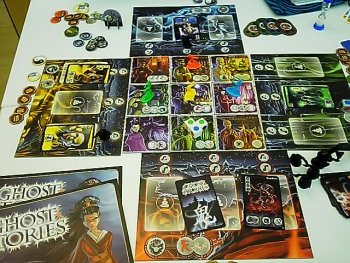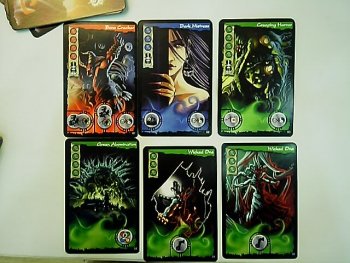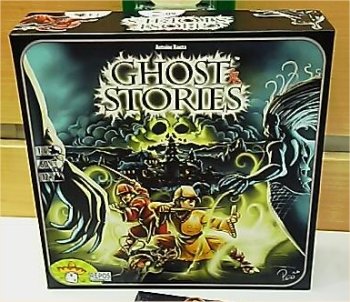![[Headline]](../technik/sonstige/headtran.gif)
![[Headline]](../technik/sonstige/headtran.gif)
![[IMAGE]](../bilder/ghoststo.gif) |
Author: Publisher: No. of Players: Awards: |
![[IMAGE]](../technik/box/rot/rot-5.gif) ![[IMAGE]](../technik/box/gelb/gelb-10.gif) ![[IMAGE]](../technik/box/grun/grun-8.gif) ![[IMAGE]](../technik/box/pink/pink-7.gif) ![[IMAGE]](../technik/box/blau/blau-9.gif) |
|
Since their rather successful start with Ca$h'n Gun$ Cedrick Caumont and Thomas Provoost from REPOS PRODUCTION have invested their time not only in the creation of expansions and alterations for their first produced game, but as I had found out last year they also had been experimenting with a new game about a horde of Ghosts threatening a peaceful Chinese village. Now They are back with a game created by Antoine Bauza, and Ghost Stories actually takes the players directly into a setting which could have been found in the great movie "Chinese Ghost Story". A peaceful village has been erected over the grave of the fearful wizard Wu-Feng who had been slain centuries ago, but now the wizard finally has gathered enough power in the underworld to try to wreak his revenge on the world of the living. So, the players take up their positions as Taoist Monks, guardians of the village and the last hope against the incoming hordes of ghosts. In the middle of the table a village of nine different buildings is set up in three rows of three buildings, and the figures of the players' Taoists are placed at the center building. Each player then takes up his own gameboard and aligns it to the row of three buildings which faces his side of the table, additionally receiving Life point counters, a YinYang token and a Tao token of his colour. A deck of ghost cards is shuffled, and then a random incarnation of Wu-Feng is placed as the 10th card from the bottom of the deck without the players actually knowing which incarnation it is.  A player's turn in the game consist of two phases, the Yin phase in which the Ghosts in play will act and the Yang Phase in which the active player has the chance to react to the actual threat with his Taoist.t the beginning of the game there are no Ghost cards present in the three slots on each player's gameboard, but in case an empty slot exists the active player has to draw a new ghost card and place it on the correspongdingly coloured board. If the board corresponding to the colour of the ghost has no available slot the ghost will be placed on another board with an empty slot at the choice of the player.Thus, the first round of play will lead to the appearance of a ghost in each player's turn, and this will continue every time an empty slot is available on the active player's gameboard. However, letting all three slots get filled by ghosts is not of use either, since such an "overrun" situation will result in the active player loosing a Lifepoint. The actions of the ghosts are detrmined by a row of symbols on the bottom of their cards, and whereas some of them influence the rules of the game by putting restrictions on the players a special class called Haunter actually will cause a figure of a ghost being placed on the ghost's card. In following Yin phases this ghost figure will be moved forward one step per turn, and when it has moved two steps it has come to the border of the village. There it will cause the first open building in its way to be shut down (its cards is placed face down), and after this the ghost figure is placed back on the card to start yet another approach. In the Yang phase the active player may move his Taoist for one step within the village, and after the movement he has either the option to use the special function of the building he occupies or - if he stands on one of the eight outer buildings and is facing ghost card on the adjacent gameboard - to try to defeat the ghost. This is called an exorcism, and in order to defeat the ghost the player has to roll three Tao dice which will show either one of the four ghost colours or white as a joker colour. Each dice matching the colour of the ghost and the white jokers count as a hit against the ghost, and if the number of hits scored actually equals the ghost's resistance rating the ghost is defeated and removed from the game. If the result of the diceroll is not sufficient the players may add Tao tokens of the matching colour which he might have acquired during the game. Quite often the removal of a ghost actually will result in an additional effect, so that the players either may receive a benefit or the ghost will cause some final shockwave if mischieve before it goes dissipates. Typical benefits are the gaining of a Lifepoint or a Tao token, but the players also may get entitled to get back their YinYang token if they should have used it. This token can be used during a player's turn to consult one of the villagers without actually visiting his building, and so an additional benefit may be used during an otherwise normal turn. The village itself consists of a arrangement of nine typical buildings, and amongst these are a Buddhist Temple, a Herbalist Shop, a Cemetery and a Tea House. Each of the buildings has its own special functions, so that a visit to the Tea House will restore one Lifepoint whereas the Herbalist will give the player two Tao tokens. Quite interesting is the Buddhist Temple in which a player may acquire a small Buddha Statue which he may use to block one of the ghost spaces on the gameboards against the next ghost to appear, and in the Cemetry even the lifeless body of a killed Taoist may be brought back into the game. Each of the four Taoists actually possesses two special powers of his own, so that one of them can use special kinds of movement whereas the other can manipulate the dice. The third can perform two actions per turn, and the fourth actually has a special Mantra of Enfeeblement which may be casts to reduce a ghosts resistance to one. Whereas the presence of just a few ghosts still might seem tolerable for the players, there quickly comes a point when the players need to get rid of newly arriving ghosts quickly in order to avoid being overrun by them. Some of the ghosts have nasty powers, banning the use of Tao dice or tokens until the ghost is slain or even forcing the active player to make a roll on the Course dice which usually will cause some negative implications. The game comes to its cumulating point when the incarnation of Wu-Feng is revealed shortly before the deck of ghosts is used up, and now the evil wizard himself will join they fray with his considerable special powers. In addition to the fact that the incarnation is hard to slay because of a high resistance level, each incarnation possesses a different special power which will restrict the access of the players to some kind of benefit. The game is won if the players succeed in defeating We-Feng's incarnation and surviving the damage caused by his destruction, whereas the players loose if all of them are killed, if more than three buildings have been closed or if the stack of ghost cards is exhausted. However, to keep the players to the challenge the designers actually have included four different levels in the game, and where the Beginner's level only is supposed to be useful for teaching the game and learning it, the final "Hell" level is rumoured to be endorsed by Wu-Feng himself. The rising levels basically twist some of the conditions in the game so that the player's Lifepoints are reduced and the number of buildings which may be closed is reduced as well, and these minor changes are said to make the game much harder. In addition, some special rules are included so that the number of four players is not fixed but instead the number of participants in the game actually may vary from four to one.  Once in a while my wife and I lean back to watch "Chinese Ghost Story" which is one of our favourite movies, and so I must confess that I am rather taken with this game. The artwork which has been used may look a bit dizzying when you see the game and cards all placed out for the first time, but a closer scrutiny reveals that it is absolutely beautiful with loads of details. This impressive playing atmosphere is taken up by the rules which - for my finding - reflect the background story of the valiant defence of a threatened village rather well. The players find themselves plotting and discussing their actions, and then hurrying from place to place to keep the outer borders of the village from being overrun by ghosts. Thinking of this breathtaking atmosphere, I guess that the game would suffer a bit of a slowdown if a playing group would try to plan their moves with highest perfection, and I guess that this kind of calculations would be somewhat against the spirit of the game. Nonetheless, even the beginner's level has a certain degree of difficulty which the players have to cope with, and thus many gamers should love this group experience game.  | ||
|
| |

Looking for this game? Visit Funagain Games! |
|
|
| |
|
Impressum / Contact Info / Disclaimer Kulkmann@aol.com
Copyright © 2008 Frank Schulte-Kulkmann, Essen, Germany | |